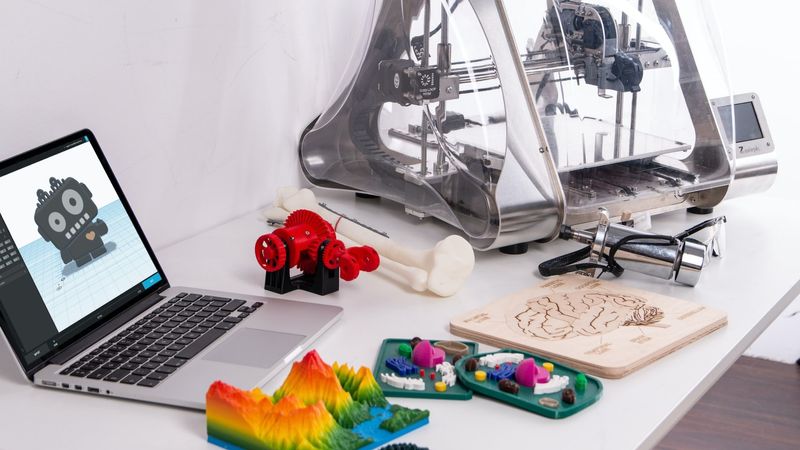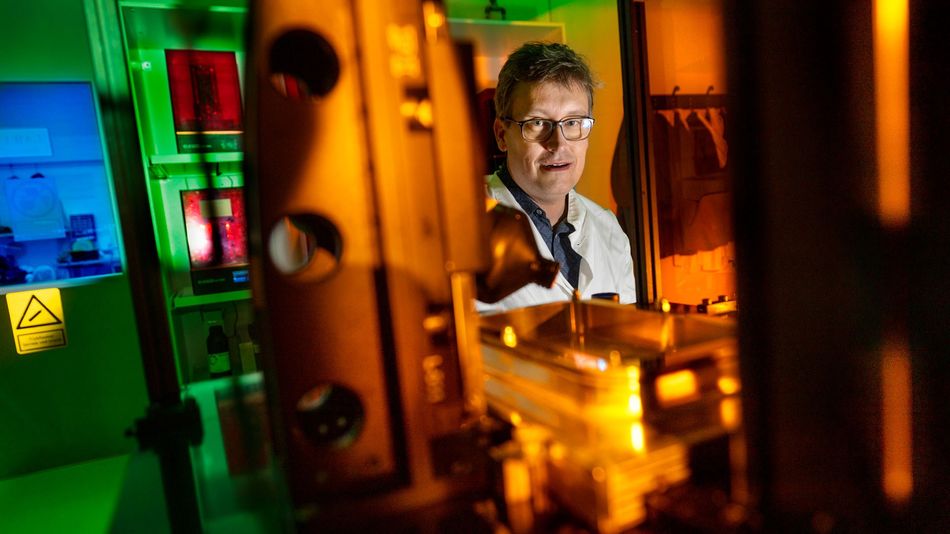3D printing is great, but not for everyone
Although 3D printing was predicted to be more widespread than it has turned out to be, the technology is still undergoing enormous development. Senior Researcher David Bue is in charge of establishing DTU’s giant ‘3D printing playground’, where new records for miniature printing are currently being set.

Photo by Xiaole Tao on Unsplash
Everything can be printed - from garden gnomes to pizzas - and we will all soon have a 3D printer at home, enabling us to produce whatever we want. This was the media’s prediction in the period after the first 3D printing patents expired in 2009 and the printers became cheap enough for ordinary people to obtain one.
But as you know, things didn’t work out that way. Not least because this statement did not entirely make sense - very few people are able to draw the object they want to print on a computer, which is the first step in the 3D-printing process.
“No, 3D printing did not become an industrial revolution as predicted; rather, it has been an evolution. But the technology is still undergoing huge development within certain special niches and is now the second fastest growing technology in the world,” says David Bue Pedersen.
He is a senior researcher at DTU and probably the person in Denmark who knows the most about 3D printing. He was the first to complete a PhD on the subject back in 2012, and he has since established a thriving research environment at DTU.
After the hype
David gets annoyed thinking about the hugely inflated expectations for 3D printing. Therefore, he has chosen to differentiate himself from the initial hype around the technology and focus his research on the industrial application, which in technical terms is called ‘additive manufacturing’. He talks enthusiastically about the technology’s great potential:
“It’s incredibly easy to 3D print very advanced components that would be extremely difficult to make conventionally,” he begins.
Gas turbines for the aviation industry, for example, must be able to cope with extremely high combustion temperatures. This means you want to build them in harder and stronger materials, but these are also much more difficult to work. On a 3D printer, you can build up your workpiece to nearly the final geometry, and then you just have to finish it off with a diamond tool.
You can likewise avoid a cumbersome casting technique involving a lot of handwork if you 3D print individually fitted hearing aids. And small components such as the hearing aids’ sound channels, which are easily clogged with earwax, may even be printed with cilia to make them self-cleaning.
Metal objects, typically made of titanium, can also be printed with porous surfaces that, for example, enable bone to ‘grow into’ implants such as artificial hips, making it possible to avoid the glue that in some cases has proven problematic.

Openness drives technology development
You can buy larger or smaller 3D printers on the market, but according to David, it is not much different from buying an inkjet printer: It can only do one thing, the technology is locked, and you are dependent on the supplier. The market as a whole is very closed, which hampers innovation and maintains artificially high prices. David wants just the opposite.
“We want to open the black box and look at the technology from a holistic approach, where we can dive into all the details and their interactions and change them as needed,” he says.
In 2019, the Poul Due Jensen Foundation granted DKK 21.3 million to the Open Additive Manufacturing initiative. And an old casting hangar is currently being transformed into a 3D playground where David and his team can explore and develop all kinds of metal and plastic prints. The ceiling is nine metres high, and one of the laboratories will be housed in a tower made from old shipping containers.
“We want to create an innovation environment that can inspire all the young DTU talents to further the use of 3D printing in Denmark,” he says.
David describes himself as a multi-artist with a broad knowledge of all the many different subjects needed to understand 3D-printing technology; e.g. construction, computer science, physics, chemistry, and materials and manufacturing engineering. And he has gathered 25 researchers and students with a deep knowledge of each their subject for his team.
“They make a great team and work seamlessly together; there is no silo research, because it is precisely in the interfaces that magic happens. I am proud to be able to equip these young and enthusiastic people with a strong toolbox in additive manufacturing before they are let loose in the industry or wherever else they end up. It benefits both research and industry - and indeed society as a whole.”
“I’m just an engineer”
David started at DTU in 2003, when there was more freedom of choice in planning his Master’s degree than under the current curriculum. He wanted to know as much as possible about as many subjects as possible, so he entered all the special courses he could.
“My education doesn’t have a direction, I’m just an engineer,” as he puts it.
Before joining DTU, he was a certified system developer at Microsoft, and in his spare time he repaired vintage cars and motorcycles.
“I was passionate about both and could have ended up almost anywhere within system building. From beet harvesters to airplanes, I could have engaged 100 per cent in it all. I was just very inquisitive and fascinated by technology, and I couldn’t get enough of building systems and understanding how they’re constructed and how they work,” he smiles.
But he ended up doing a PhD in 3D printing and subsequently agreed with his boss that DTU could probably drive this field further. Since then, the laboratory has continued to grow, and a large part of the equipment has ended up in the corridors. From there it will now soon move into the new hangar. All the machines have been built by the researchers themselves in completely open structures. Every detail is documented and can therefore be modulated depending on how they are used.
Miniature plastic print record
You print in metal by pulling a powder as fine as flour across a wallboard, scanning it with a laser and thus welding it together into a solid material. The laboratory’s metal printer can weld at very high speeds, and the researchers are developing the gradation of metal alloys with different functions. They also have equipment to monitor the process and detect any welding defects as they occur, and to study the finished material. Here, for the first time in the history of the world, it has been possible to print the famous Damascus steel, which is used for, e.g., kitchen knives.
In the wet lab, researchers work with liquid plastic like the kind used for dental fillings. The objects are built layer by layer, which are gradually hardened using a UV light. David’s group also built this equipment from scratch, and three PhD students recently set a new record when they printed a plastic figure using a print solution that can be measured in microns, which has not been seen before. David challenged them to downsize even further, and after some recoding, they were able to present the same figure with details smaller than a micron.
“My goal is to show what could happen if manufacturers set 3D technologies free, enabling buyers to optimize on different parameters instead of just pressing the start button. And I help Danish companies adopt 3D printing and thus streamline production,” David summarizes.
Fun, but not just for fun
It almost goes without saying that a dedicated 3D-printing enthusiast must also own a 3D printer.
“Yes, at one point I had between six and eight printers in the basement. But now there’s just an old Puch Maxi moped that I mess around with a bit. I have all the printing equipment I can dream of in the lab.”
And what does the expert himself print?
“Certainly not garden gnomes and ladles. It’s much easier to obtain those from Ikea or DIY centres. I’ve mostly done custom upgrades for my 3D printer, so I didn’t have to have them manufactured in a workshop,” he says and concludes:
“When the guy who researches 3D printing doesn’t use 3D printers at home, it speaks volumes about the technology. If you buy a large, expensive printer for DKK 15 million and completely take it apart, you will find almost no printed elements in it. So 3D printing is not as universally applicable as it was predicted to be. But it’s great for a lot of specialized tasks.”